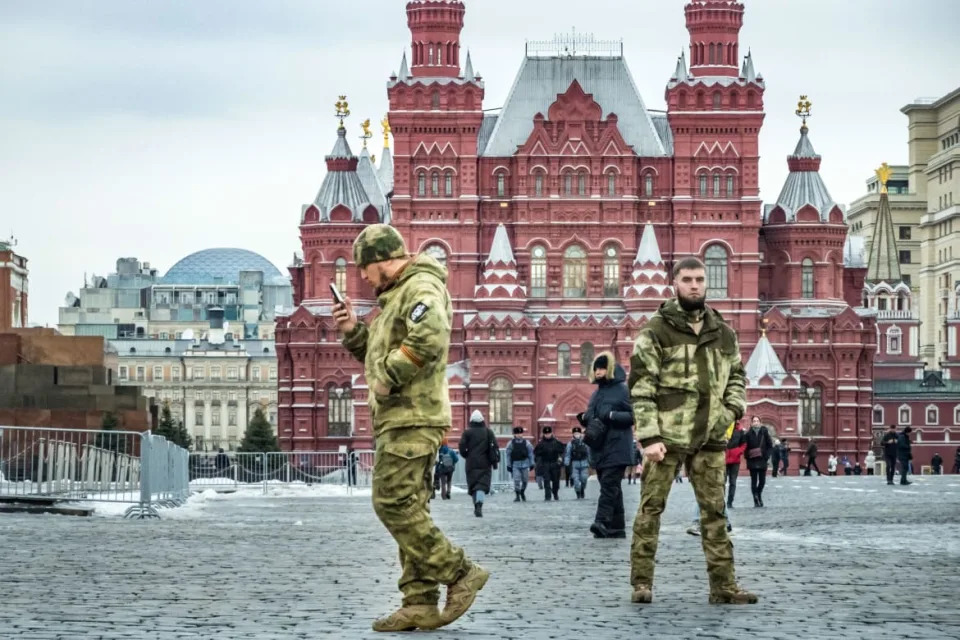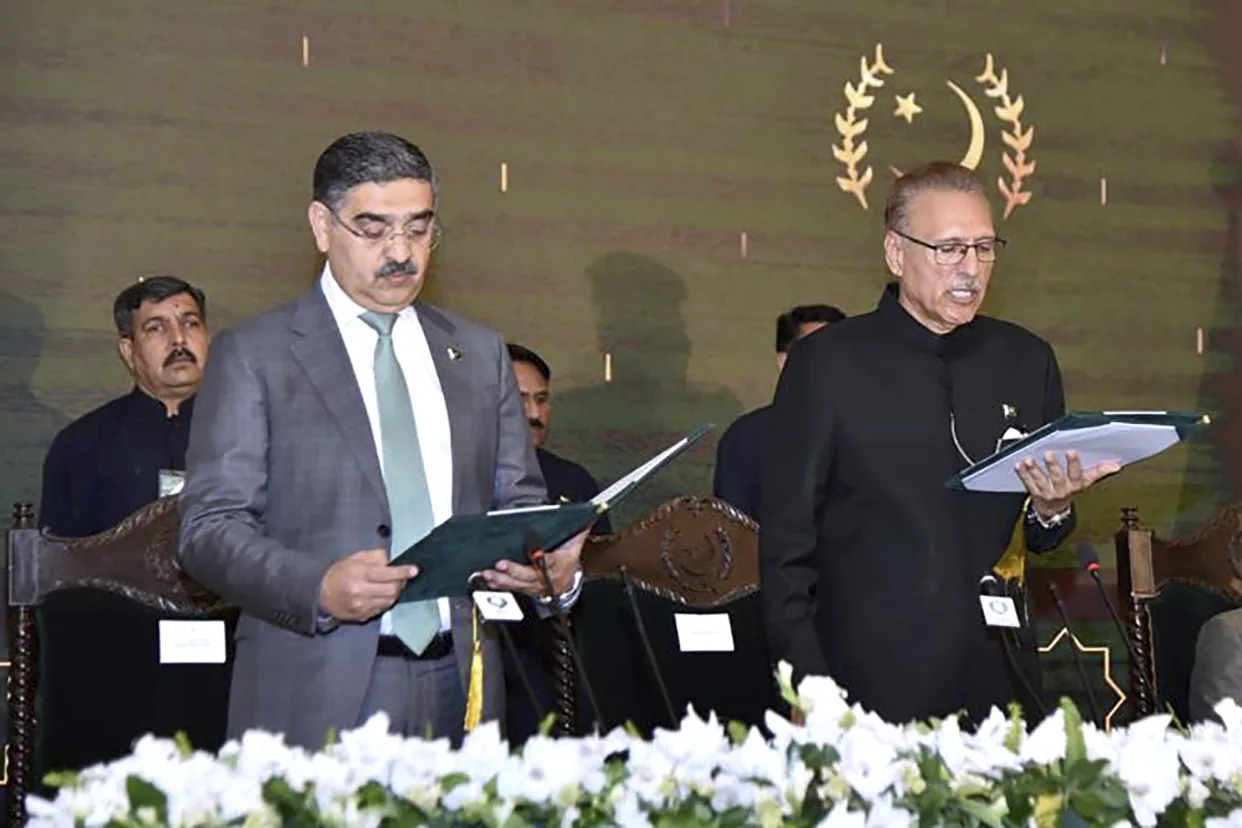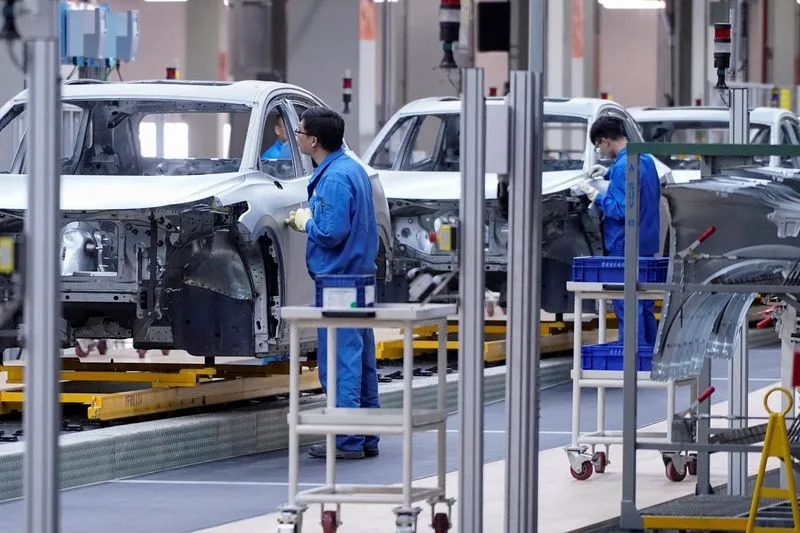Will McCurdy
The Daily Beast
Mon, September 4, 2023

Photo Illustration by Elizabeth Brockway/The Daily Beast/Reuters
All eyes are on the Russian mercenary group Wagner in the aftermath of a mysterious plane crash that presumably killed the group’s leader, Yevgeny Prigozhin, and his right-hand man, Dmitry Utkin, last week. Angry over what many suspect was an assassination plot ordered by Russian President Vladimir Putin himself, many factions within the infamous mercenary group are now emerging with shadowy threats of vengeance and violence.
The “Rusich” Sabotage Assault Reconnaissance Group, a Wagner-linked unit of fighters that have received additional sanctions for “special cruelty" in battles in the Kharkiv region in Ukraine, has recently taken to Telegram to post one such ominous warning. “Let this be a lesson to all. Always go all the way,” the group said in a statement after the plane crash.
There’s good reason for Vladimir Putin to take threats from Rusich, and other like-minded Wagner fighters, seriously.
That’s because behind the headlines, many of the Wagner units most known for their violence—including the Rusich battalion, and even the now-deceased commander Dmitry Utkin—are fighting what they believe is a spiritual battle, taking religious and ideological inspiration from sources far removed from the Russian mainstream.
These soldiers are shunning Jesus, Mary, and the Russian Orthodox patriarchs, and instead booking to Gods such as Perun— the ancient Slavic god of thunder and lightning—for protection and inspiration.
Mon, September 4, 2023

Photo Illustration by Elizabeth Brockway/The Daily Beast/Reuters
All eyes are on the Russian mercenary group Wagner in the aftermath of a mysterious plane crash that presumably killed the group’s leader, Yevgeny Prigozhin, and his right-hand man, Dmitry Utkin, last week. Angry over what many suspect was an assassination plot ordered by Russian President Vladimir Putin himself, many factions within the infamous mercenary group are now emerging with shadowy threats of vengeance and violence.
The “Rusich” Sabotage Assault Reconnaissance Group, a Wagner-linked unit of fighters that have received additional sanctions for “special cruelty" in battles in the Kharkiv region in Ukraine, has recently taken to Telegram to post one such ominous warning. “Let this be a lesson to all. Always go all the way,” the group said in a statement after the plane crash.
There’s good reason for Vladimir Putin to take threats from Rusich, and other like-minded Wagner fighters, seriously.
That’s because behind the headlines, many of the Wagner units most known for their violence—including the Rusich battalion, and even the now-deceased commander Dmitry Utkin—are fighting what they believe is a spiritual battle, taking religious and ideological inspiration from sources far removed from the Russian mainstream.
These soldiers are shunning Jesus, Mary, and the Russian Orthodox patriarchs, and instead booking to Gods such as Perun— the ancient Slavic god of thunder and lightning—for protection and inspiration.

Members of the far right Russian paramilitary unit Rusich take a walk in the Kremlin square during a break in their participation in the Russian invasion of Ukraine
STR/NurPhoto/Getty
The “Rusich” battalion is formed almost entirely of adherents of a variant of Slavic neopaganism known as “Rodnovery,” according to former unit commander Alexei Milchakov’s interviews with local Russian media. Marat Gabidullin, who served in the Wagner group from 2015 to 2019 and rose to the rank of commander in Syria, also confirmed these reports to The Daily Beast.
Members of the Rusich group, which has been active in Ukraine’s Donbas region, Africa, and Syria since 2014, have often adorned their badges, tanks, and banners with images of what’s known as the ‘kolovrat’. This spinning wheel—one of the critical symbols of the pagan revivalist belief system—could be easily mistaken for a swastika by the untrained eye. Pagan symbols such as the ‘Valknut’ and ‘Black Sun’ have also frequently appeared on the groups’ uniforms and banners.
These pagan symbols have prompted disgust and confusion in several news outlets, in both Ukraine and Africa, due to the symbols bearing a distinct similarity to the SS imagery of Nazi Germany. Outside of the Rusich unit, these pagan beliefs are common among members of the Wagner Group, and the Russian military more widely, according to several sources who spoke to The Daily Beast.
‘Rodnovers’ practice polytheism, the belief in multiple gods, roughly seven, all said to be manifestations of the one true god Rod. These ideas began to take root in the ’90s, when the collapse of the Soviet Union and state atheism led to a revival of religious faiths of all kinds, including Christianity.
Men are hugely overrepresented in Rodnovery, particularly those involved in martial arts clubs and the heavy metal community, where its imagery often crops up. A core text of Rodnovery, “The Book of Veles” places the Slavs as a type of chosen people, with a unique destiny. Though texts like the above have proven likely to be 19th-century forgeries and much of the faith represents guesswork based on incomplete records from Medieval scholars, that hasn’t stopped these beliefs from slowly rising in popularity.
There are estimated to be between several 100,000 to several million Pagans in Russia, divided between different sects with quite diverse beliefs. The deity that receives the bulk of the attention, at least among male devotees, is Perun, a deity who in the Book of Veles engages in constant war against the forces of evil, not unlike the popular Norse god Thor. The belief in reincarnation is also common among believers.
Gabidullin, the ex-Wagner soldier, told The Daily Beast the practice of Rodoverny within the group as merely a type of “fashion hobby” for a marginalized community of soldiers.
The ex-mercenary says the popularity of these beliefs stems from the “laziness to study the scientific school of history” and the desire to find a justification “for self-aggrandizement in the past.” He terms the vision of the history of Rodverners in Wagner as an: “invented version with great ancestors and achievements.”
Expressing sympathy with Rodnovery may even get you promoted within the Wagner Group. A group of anonymous informants, who served in the Wagner group in Syria, told a Ukrainian publication Radio Liberty in 2018 “it is desirable to be a Rodnover” to progress in the Wagner group.
Hundreds of Wagner Men Vanish From Putin’s Designated Exile
Gabidullin, in a previous interview with a Russian language publication, has alleged that Dimitry Utkin, the group’s recently deceased commander, has Pagan beliefs of his own, alleging the general has multiple Rodnovery-inspired tattoos.

Portraits of Yevgeny Prigozhin and Dmitry Utkin are seen at a makeshift memorial in Nizhny Novgorod, Russia August 27, 2023.
Anastasia Makarycheva/Reuters
The insider also alleged that there was “an ideological department within the Wagner PMC (private mercenary company),” formed back in 2019 that is promoting the movement, which he derides as merely a “disguised form of Nazi ideology.”
Denys Brylov, a Ukrainian scholar focused on religion in the Slavic world, believes that the actual specific religious practices of the Rodnovers serving in Wagner may come secondary to the wider ideological component it can provide for soldiers.
Brylov believes that for Wagnerites neo-paganism is attractive due to its ability to provide a spiritual justification for the “cult of force”. In these types of fringe, hardline interpretations of pagan beliefs, the very act of battle or the shedding of blood can be “considered as an act of sacrifice to the pagan patron deities of warriors and war.”
That said, Brylov feels that in many cases persons “inclined to cruelty” may simply gravitate to neo-pagan ideology to justify these instincts, rather than the beliefs themselves being inherently warlike.
Rusich commander Alexei Milchakov, for instance, went viral on VK—effectively Russia’s Facebook—for beheading and eating a puppy, while barely out of his teenage years, and well before he joined the army. He would later joke he respected canines' rights to be “1-tasty, 2-fried, 3-not have a lot of veins and bones.”
Neopaganism in the West, which started to first grow in the 1960s, has yet to shake lingering associations with flower power and the hippie movement, though this hasn’t always been the case. Norse Neopaganism, the revival of old Viking and Northern European religious traditions, has often been co-opted by the far right, both in Scandinavia and in the U.S. Popular heavy metal musicians such as the Norwegian Varg Vikernes, who has served a 15-year jail sentence for murder, employ long-winded, fairly academic descriptions of Nordic paganism as a justification for antisemitism and a protest of what they view as the corrupting influence of Anglo-American liberalism. In the U.S., Norse revivalist ideas have become popular in Neo-nazi or skinhead groups, and there are even seen Asatrú ministries—a type of revivalist Norse paganism—popping up in jails across the country.
Western neo-pagans, at least between the 1960s and early 1980s, generally but by no means always, leaned left, anti-war, and pro-environment, and were seeking a more earth-centric religious philosophy. Now, western neo-pagan movements have shifted to include large numbers of individuals from across the left and right of the political spectrum.
Still, there is a definite bent towards libertarianism, according to Adrian Ivakhiv, a professor at the University of Vermont who has conducted research into Ukrainian pagan revivalism, which includes 'Ridnoviry,’ among other overlapping traditions.
Rodnovery, in contrast, tends to be marginally more socially right-wing than Western forms of neo-paganism and may portray Western liberalism and consumerism as a corrupting influence.
Rodnovers, according to Ivakhiv, ‘definitely’ often have a streak of Western anti-liberalism, because they see liberalism as a secularizing force that threatens traditional social institutions such as families and communities.
Ivakhiv feels that Rodnovery, in some but certainly not all manifestations, can play into the vaguely esoteric, right-wing sort of spirituality you can find the world over, uniting the Steve Bannon wing of the American right with the “Alexander Dugin wing” of Russian conservative politics that is intensely anti-secular.
Alexander Dugin, a Russian far-right political philosopher, is primarily known for conspiratorial rhetoric. He promotes neo-imperialist viewpoints known as ‘Eurasianism’ and characterizes Western liberalism as a spiritual evil. His popular book, The Foundations of Geopolitics, has been attributed by some sources as having some influence on Russian foreign policy and Vladamir Putin, even being called “Putin’s Brain,” although these claims are heavily disputed.
According to Ivakhiv, you would find certain strains of this anti-western thinking in both Ukrainian and Russian pagans. Ivakhiv believes this is more common among Russian pagans than in Ukraine, and many Ukrainians still see Russians as fellow slavs and blame Putin’s regime, not Russians in general, for the war.
Ivakhiv admits it is difficult to generalize, but that Ukrainian Rodnovers will tend to see as much commonality with Polish, Czech, Slovak, and South Slavic pagans as with Russian or Belarusians.
No area better demonstrates the appeal of Rodnovery among young Russian males than combat sports. In fact, these beliefs are held by some of the most successful Russian athletes. Heavyweight boxer Alexander Povetkin, who at one time held the WBA belt and had a high-profile title bout against Vladamir Klitschko in 2014, is a self-admitted pagan. He regularly wears a necklace of the Axe of Perun on his chest and on his left shoulder, and he has a tattoo of the star of Rus, another popular symbol in Rodnovery.
Povetkin has expressed some of the nationalist views that are so often parceled up with Russian interpretations of Rodnovery, telling a Russian sports publication: “I am a person who loves his homeland and his people. Therefore, consider myself a nationalist.” Though he shoots down the idea that nationalism necessarily means fascism or Nazism.
Denis Aleksandrovich Lebedev, who was also a WBA champion and was ranked as the best cruiserweight in the world at one point in 2016, has also come out as a believer, though he may have pivoted back to the Russian Orthodox Church in recent years, at least in public. Alexander Pavlovich Shlemenko, who has successfully competed in the middleweight division of UFC-competitor Bellator, has expressed pagan sympathies to local sports media.
In a collection of photos posted on the Russian social network VK, we can see members of the popular Moscow MMA club “R.O.D.b.,” potentially named after the supreme deity Rod, celebrating the key pagan festival the ‘Day of Perun.’ The aforementioned world-famous boxers are pictured wearing Rodnover garments.
Though it may be an overstatement to call combat sports clubs a recruitment pipeline for the military, there is certainly a connection there. These clubs are popular targets for Russian military advertising due to their core demographics of young males. It’s also not uncommon for the coaches and founders to have served in the Russian military, as is the case with the founder of the ROD MMA club.
Ivakhiv feels that young men involved in fields such as boxing, MMA, and military service all might be attracted to Rodnovery in part because of its traditional representations of masculinity, such as the god Perun, because it can provide a source of inspiration for hard training, a type of intense motivation that seems rooted in traditional ‘martial arts.’
Magda, a practicing Slavic pagan from Poland, who is attempting to reconstruct pagan traditions as part of the Witia Project, has her own theories about why Rodnovery might be popular with young men.
“I think that men are really lost in modern times. I think that masculinity, nobody really knows what it is anymore. Men are just looking for something that will tell them how to be.”
Magda also believes that Rodnovery may also appeal to young men because, at least in comparison to the Russian Orthodox church, it is pro-sex and physicality.
“In Slavic Native Faith, there's absolutely no question that physical stuff is part of it.”
“During Kupała, the Slavic pagan celebration of summer solstice, you are supposed to be in couples. You have the whole tradition of going off into the forest, which is where the couples were intimate. Men likely find this appealing.”
Russian language message boards dedicated to paganism, blocked to Western IP addresses, generally contain conservative viewpoints on most social issues such as homosexuality, abortion, and women’s place in society. There is also a clearly anti-establishment bent, with a number of posts critical of the Russian military's abuses of power as well as government censorship of the populace.
“A part of the searching for their own identity was basically just making up stuff,” Magda said. “You have all these crazy people nowadays, mostly men, and they get it in their head that they are the sons of Perun. Whether they are these fighters or these warriors, they have to gain fame or honor on the battlefield.
“It is just crazy,” she added.
Though many within the movement may use Rodnovery as a way to justify Russian nationalist ideals, so do many followers of the Russian Orthodox Church. There are likely more Muslims serving in the Russian army than Pagans, and yet many more Christians or Atheists. The Orthodox Church has arguably provided just as much backing for Russian Nationalism as Rodovery ever has, with Patriarch Kirill even personally blessing the invasion of Ukraine.
Still, it’s not surprising that a faith based so much on guesswork surrounding a long forgotten way of life, and with no central hierarchy, can attract devotees of questionable morals. For those who go into with a pre-existing tendency to be violent, bigoted, or nefarious, it’s a blank slate that offers a justification to do what they please.
And considering the current instability within Wagner and the Russian military more widely—that spiritual justification could spell trouble ahead.
The Daily Beast.




















